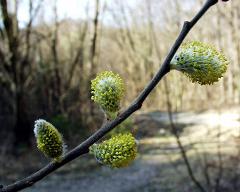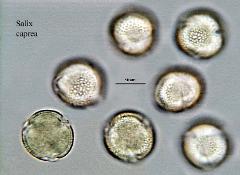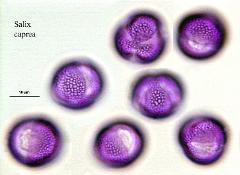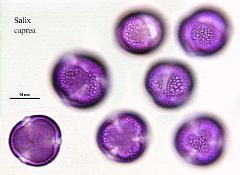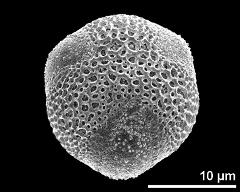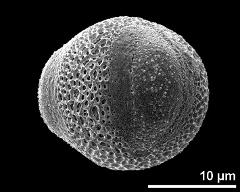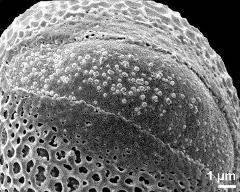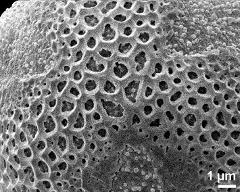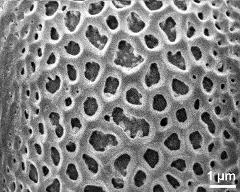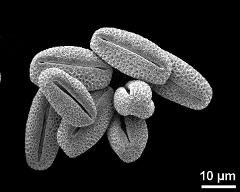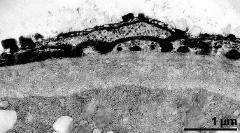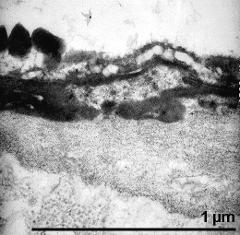Salix caprea
Taxonomy: Angiospermae, Malpighiales, Salicaceae, Salix
Published: 2020-07-28
Pollen Description
Shape, Size and Aperture
pollen unit: monad, dispersal unit and peculiarities: monad, size (pollen unit): small (10-25 µm), size of hydrated pollen (LM): 16-20 µm, shortest polar axis in equatorial view (LM): 11-15 µm, longest polar axis in equatorial view (LM): 16-20 µm, shortest diameter in equatorial or polar view (LM): 16-20 µm, longest diameter in equatorial or polar view (LM): 16-20 µm, pollen class: colporate, polarity: isopolar, P/E-ratio: -, shape: spheroidal, outline in polar view: circular, dominant orientation (LM): oblique, P/E-ratio (dry pollen): prolate, shape (dry pollen): -, outline in polar view (dry pollen): lobate, infoldings (dry pollen): aperture(s) sunken, aperture number: 3, aperture type: colporus, aperture condition: colporate, tricolporate, aperture peculiarities: margo
Ornamentation and Structure
LM ornamentation LM: reticulate, nexine: -, sexine: -, SEM ornamentation SEM: reticulate, suprasculpture SEM: -, TEM tectum: semitectate, infratectum: columellate, foot layer: discontinuous, endexine: compact-continuous, intine: monolayered, wall peculiarities: -, supratectal element: -
Miscellaneous
pollen coatings: absent, reserves in cytoplasm: -, cell number: -, Ubisch bodies: absent
Author(s) of diagnosis: Hesse, Michael; Halbritter, Heidemarie; Heigl, Helmut
Pictures
Picture legend
- flower(s), photographer: Halbritter, H.
- hydrated Pollen - fresh, glycerine, unstained, photographer: Heigl, H.
- hydrated Pollen - fresh, glycerine, ruthenium red, photographer: Heigl, H.
- hydrated Pollen - fresh, glycerine, ruthenium red, photographer: Heigl, H.
- polar view - fresh, rehydrated (water) & critical point dried & sputter coated with gold, photographer: Halbritter, H.
- equatorial view - fresh, rehydrated (water) & critical point dried & sputter coated with gold, photographer: Halbritter, H.
- aperture - fresh, rehydrated (water) & critical point dried & sputter coated with gold, photographer: Halbritter, H.
- polar area - fresh, rehydrated (water) & critical point dried & sputter coated with gold, photographer: Halbritter, H.
- exine surface - fresh, rehydrated (water) & critical point dried & sputter coated with gold, photographer: Halbritter, H.
- dry pollen grains - dry, sputter coated with gold, photographer: Halbritter, H.
- detail of pollen wall - fresh, glutaraldehyde & osmium, uranyl acetate & lead citrate, photographer: Hesse, M.
- detail of pollen wall - fresh, glutaraldehyde & osmium, uranyl acetate & lead citrate, photographer: Hesse, M.
Literature
- (1978) Entomophily in Salix: theoretical considerations. In: Richards A.J. (ed) The Pollination of Flowers by Insects. Linnean Society Symposium Series No 6 : 47-50
- (1967) Sporoderm in Populus and Salix. Grana Palynol 7: 517-567
- (1982) Entomophily in Salix. II. Efficacy and flower constancy of insects visiting some willows and sallows. Beitr Biol Pflanzen 56: 105-116
- (1998) Preparing living pollen material for scanning electron microscopy using 2,2-dimethoxypropane (DMP) and criticalpoint drying. Biotechnic Histochem 73: 137–143
Copyright and Citation
Cite this publication as:
Hesse M., Halbritter H., Heigl H. 2020. Salix caprea. In: PalDat - A palynological database. https://www.paldat.org/pub/Salix_caprea/303754;jsessionid=0E2A5642CA2182F4A915280918822C92; accessed 2025-10-03

